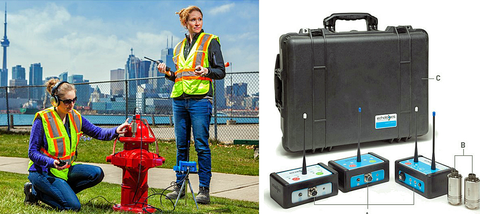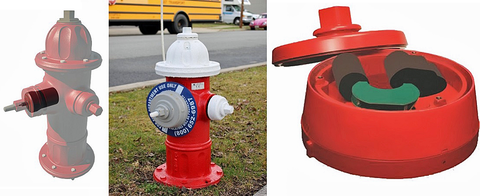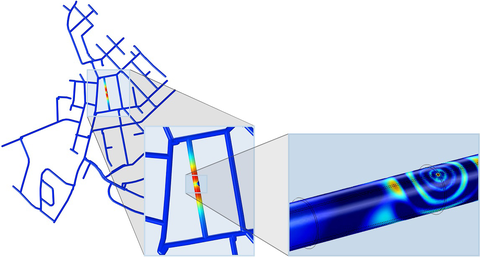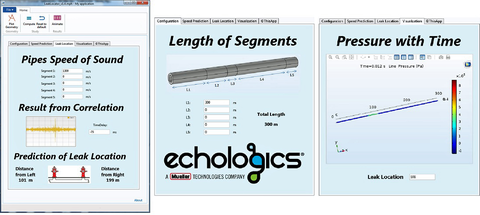
Fresh, clean water is a precious commodity that municipalities cannot afford to waste in underground pipe leaks. As pipe infrastructure ages, finding leaks becomes more difficult. As water grows in value, finding leaks becomes more critical.
That is where the Toronto-based company Echologics, a division of Mueller Canada, Ltd., with its unique acoustic technology for noninvasive leak detection, enters the picture. “Leaks make noise,” explained Sebastien Perrier, R&D acoustical scientist at Echologics. Perrier is a mechanical engineer who specializes in acoustics and vibrations, the coupling of structures, as well as signal processing. “The pipes talk and, if you listen, they’ll tell you where leaks are located,” he said.
Echologics measures the time-of-flight of the sound using a correlation function and acoustic sensors set on the pipes or fire hydrants. If a leak occurs somewhere between two sensors, the leak is detected and the correlation result is used to determine the time difference the leak noise takes to reach each sensor. This provides the distance from the leak to each sensor once the speed of sound is known in the pipes under investigation (figure 1).

Echologics designs technologies that exploit this correlation to find leaks and to continuously monitor pipes for leaks. Examples of products include the LeakFinderST leak noise correlator (figure 2) and the EchoShore-DX pipeline monitoring system (figure 3).


Echologics correlators allow field specialists to investigate leaks in a variety of pipes using transmitters, sensors, and a user interface that can be set up on a standard laptop. Since correlators monitor leaks as they grow, this acoustic technology can detect even very small leaks in the early stages of formation, saving municipalities’ money and time.
The technology powering these products requires a precise understanding of the speed of sound in different types of pipes. It is material dependent, proportional to the stiffness of the pipe, and influenced by the pipe geometry. “The key was developing technology sensitive enough to make leak detection possible in PVC pipes,” explained Perrier. Plastic has high attenuation and dampening compared with metal. Even trickier is the fact that older water systems originally made with cast iron pipes are being repaired — in individual segments — with plastic.
Keeping the sophisticated acoustic correlation algorithms up to date and accurate is one of Perrier’s responsibilities. He must understand the physics involved at a fundamental level to optimize and develop next-generation solutions for buried pipe infrastructure. To help him speed up the design process and share his findings with other departments, Perrier creates computational acoustic models and builds simulation apps based on them.
Catching Leaks Before They Cause Failures
How does numerical simulation help predict acoustic wave propagation in pipes? The pipe network analysis can be complex and time consuming. One may want to understand the sound propagation and vibration response from a single pipe perspective or from an entire network. Therefore, the complexity of the model and the time it takes to run the analysis can change considerably depending on the level of details needed for the physics involved in the model to be accurate.
Making sure that the sound propagation speed is accurate for each pipe segment is at the heart of the problem that Perrier solved at the early stage of the design process. He then adopted Multiphysics simulation to give him faster access to the values relevant to his work. In a pipe networks analysis, Multiphysics couplings between acoustics, flow, and structural mechanics are needed.
In Perrier’s work, there are multiple uses for simulation. Such as being able to understand slight margins of error and fine-tune the technology. Exploring material and geometry parameters for a pipe network through acoustics simulation reveals predictions for different scenarios. The acoustics simulation exhibits the presence of signal noise when the sensors’ distance varies, or indicates that a plastic repair must have occurred that wasn’t included in the test. Perrier’s simulation also predicts the pressure in a pipe network as the acoustic wave travels to the sensor, as well as mechanical damping accounting for sections of different materials, offering a way to visualize the problem (figure 4).

Routine Use And Simulation Apps
With routine use of the computational model, Perrier saw the advantage in building a custom simulation app. Based on his COMSOL Multiphysics analysis and using built-in tools in the software, he created his own app that combines acoustic-structure interaction, pipe acoustics, and time-dependent and frequency studies (figure 5). The app allows the user to vary geometry and material properties in multiple runs, and analyze a pipe segment or an entire network.

Using the app, a user can define a water main network by specifying segment lengths, number of segments, and pipe characteristics. Speed of sound is computed by selecting material properties from a predetermined list, such as cast iron or plastic. The simulation then incorporates the results from field measurements, which a user would manually enter based on correlations to predict leak locations.
Turning the Multiphysics model into a simulation app is convenient for interacting with others in the company. “By building simulation apps, I can share a complex model with colleagues and make it accessible anywhere,” Perrier said. Simulation apps can be password protected and deployed with a local installation of the COMSOL Server product, making it possible to quickly push app updates and maintain confidentiality. This was a key attribute for him, noting that much of what he does is confidential. He created the app so it could be run by field engineers’ on-site.
He expects that the app will be broadly used within Echologics. The key is for Echologics field engineers to be able to quickly and accurately find leaks without having a detailed understanding of the mechanics or mathematics behind the simulation. A powerful tool, in Perrier’s vision, is a simulation that visualizes the propagation of sound and lets users see whether the speed of sound is decreasing or increasing when the geometry or material properties change.
About the author
Valerio Marra is the marketing director at COMSOL in Burlington, MA. Previous roles include working in applications, technical support, and sales. He has been at COMSOL since 2008. Valerio received his PhD in fluid machines and energy systems engineering and his MS in nuclear engineering, focusing on numerical methods for CFD.